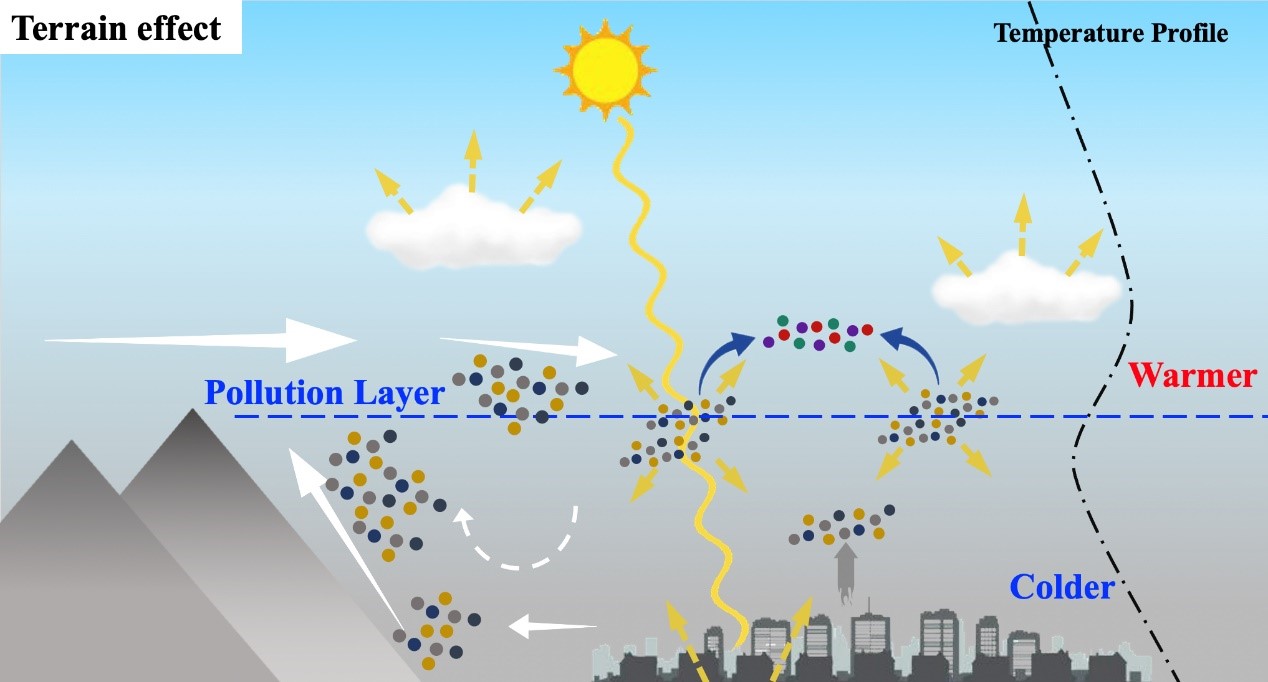The North China Plain (NCP), one of the world’s most polluted regions, is frequently engulfed by severe haze in the cold season, which has aroused broad public concern because of the adverse impacts on air quality, atmospheric visibility, and human health. Previous research has shown that the distinctive topography around the NCP favors air pollution via unfavorable meteorological conditions such as atmospheric stagnation; however, our understanding of the effects on atmospheric physical and chemical processes and their interactions is still limited.
Prof. Xin Huang and her research group from Nanjing University, China, explored the impact of complex terrain on the occurrence and evolution of haze pollution in the highly polluted NCP region by integrating in-situ observations and meteorology–chemistry modeling. They found that the complex terrain can greatly enhance secondary haze formation by blocking and lifting near-surface air pollutants and accelerating their chemical transformation. Worse still, the thick haze aloft can further intensify the interaction between aerosols and the planetary boundary layer (PBL) via heating the upper air and cooling the surface, which leads to more stagnant air and forms a positive feedback loop. These terrain-induced intensive interactions of physical and chemical processes of atmospheric aerosol jointly contribute to the relatively more severe haze pollution in the NCP region. The findings have been recently published in Atmospheric and Oceanic Science Letters.
“During haze events, cities located near the complex terrain frequently suffer from severe pollution because of the blocking effect of the mountains. This leads to atmospheric stagnation, which favors the continuous accumulation of freshly emitted pollutants near the ground surface,” explains Prof. Huang.
Considering severe pollution events in northern China are to a large extent driven by the formation of secondary aerosol, the team further analyzed the evolution of secondary pollution in the uplifted polluted air mass. They found that the main secondary inorganic aerosol accounted for over 70% of the fine particulate matter mass concentration during a heavy pollution episode.
“The upper air always features stronger oxidizing capacity compared to the ground surface, especially during wintertime. In this case, the uplifted primary pollutants can be readily oxidized in the upper air, which exacerbates the secondary aerosol formation,” outlines Prof. Huang. “Eventually, vertical mixing and deposition of secondary pollutants will further lead to the aggravation of pollution on the ground.”
This study also points out that the effect of terrain on pollution can be accompanied by intense aerosol–PBL interactions. During uplift-polluted days, the temperature stratification in the lower troposphere is significantly modified.
Based on online meteorology–chemistry coupled modeling, the team’s work further indicates that the aerosol-induced upper-air heating and surface dimming effects stabilize the atmospheric stratification and lead to about a 50% drop in the PBL height, which further aggravates the air pollution.
By expounding the mechanism underlying the effect of complex terrain on pollution in the North China Plain region, this research emphasizes the importance of such an effect on the intense interaction between atmospheric physical and chemical processes. It could be a crucial factor for the frequent occurrence of air pollution in mountainous and coastal areas near complex topography.

Effect of terrain on air pollution over the North China Plain region (Credit: Jingyi Liu)
Link:
https://doi.org/10.1016/j.aosl.2022.100273
Citation:
Jingyi Liu, Lian Xue, Xin Huang, Zilin Wang, Sijia Lou, Aijun Ding, 2022. Intensified haze formation and meteorological feedback by complex terrain in the North China Plain region. Atmospheric and Oceanic Science Letters, https://doi.org/10.1016/j.aosl.2022.100273.
|